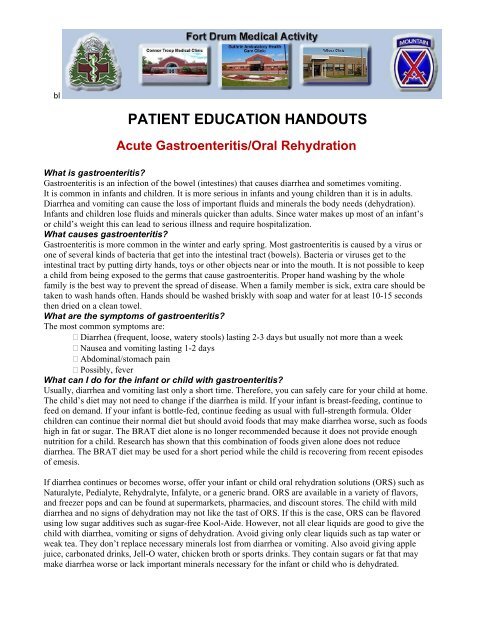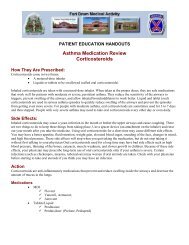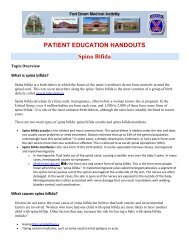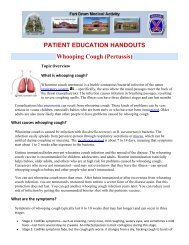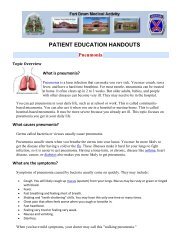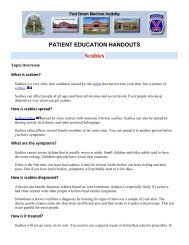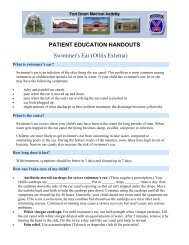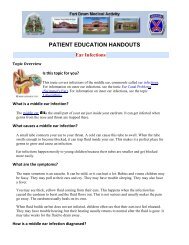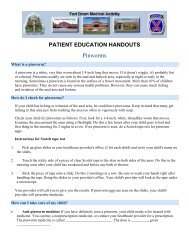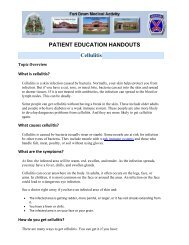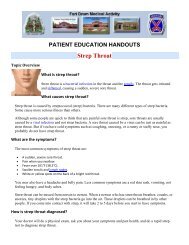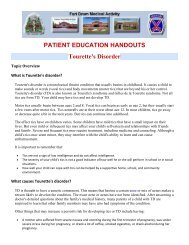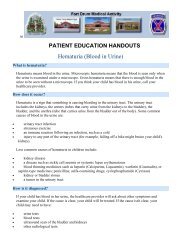patient education handouts - US Army Medical Department Activity ...
patient education handouts - US Army Medical Department Activity ...
patient education handouts - US Army Medical Department Activity ...
You also want an ePaper? Increase the reach of your titles
YUMPU automatically turns print PDFs into web optimized ePapers that Google loves.
lPATIENT EDUCATION HANDOUTSAcute Gastroenteritis/Oral RehydrationWhat is gastroenteritis?Gastroenteritis is an infection of the bowel (intestines) that causes diarrhea and sometimes vomiting.It is common in infants and children. It is more serious in infants and young children than it is in adults.Diarrhea and vomiting can cause the loss of important fluids and minerals the body needs (dehydration).Infants and children lose fluids and minerals quicker than adults. Since water makes up most of an infant’sor child’s weight this can lead to serious illness and require hospitalization.What causes gastroenteritis?Gastroenteritis is more common in the winter and early spring. Most gastroenteritis is caused by a virus orone of several kinds of bacteria that get into the intestinal tract (bowels). Bacteria or viruses get to theintestinal tract by putting dirty hands, toys or other objects near or into the mouth. It is not possible to keepa child from being exposed to the germs that cause gastroenteritis. Proper hand washing by the wholefamily is the best way to prevent the spread of disease. When a family member is sick, extra care should betaken to wash hands often. Hands should be washed briskly with soap and water for at least 10-15 secondsthen dried on a clean towel.What are the symptoms of gastroenteritis?The most common symptoms are:Diarrhea (frequent, loose, watery stools) lasting 2-3 days but usually not more than a weekNausea and vomiting lasting 1-2 daysAbdominal/stomach painPossibly, feverWhat can I do for the infant or child with gastroenteritis?Usually, diarrhea and vomiting last only a short time. Therefore, you can safely care for your child at home.The child’s diet may not need to change if the diarrhea is mild. If your infant is breast-feeding, continue tofeed on demand. If your infant is bottle-fed, continue feeding as usual with full-strength formula. Olderchildren can continue their normal diet but should avoid foods that may make diarrhea worse, such as foodshigh in fat or sugar. The BRAT diet alone is no longer recommended because it does not provide enoughnutrition for a child. Research has shown that this combination of foods given alone does not reducediarrhea. The BRAT diet may be used for a short period while the child is recovering from recent episodesof emesis.If diarrhea continues or becomes worse, offer your infant or child oral rehydration solutions (ORS) such asNaturalyte, Pedialyte, Rehydralyte, Infalyte, or a generic brand. ORS are available in a variety of flavors,and freezer pops and can be found at supermarkets, pharmacies, and discount stores. The child with milddiarrhea and no signs of dehydration may not like the tast of ORS. If this is the case, ORS can be flavoredusing low sugar additives such as sugar-free Kool-Aide. However, not all clear liquids are good to give thechild with diarrhea, vomiting or signs of dehydration. Avoid giving only clear liquids such as tap water orweak tea. They don’t replace necessary minerals lost from diarrhea or vomiting. Also avoid giving applejuice, carbonated drinks, Jell-O water, chicken broth or sports drinks. They contain sugars or fat that maymake diarrhea worse or lack important minerals necessary for the infant or child who is dehydrated.
Foods good to offer your child are:Cereals, bread, potatoes, lean meatsPlain yogurt, bananas, fresh applesVegetables(Foods may be better tolerated in smaller more frequent feedings.)Children may need twice as much fluid as usual when they are vomiting or have diarrhea. To getmore fluid in the child, continue regular feedings while giving them an oral rehydration solution(ORS) frequently between meals.Oral rehydration and early re-feeding:These guidelines apply to otherwise healthy children with acute gastroenteritis from ages 1 month to 5years. Oral rehydration followed by early re-feeding is the treatment of choice for children with mild tomoderate dehydration. Intravenous (IV) rehydration is generally not required in these <strong>patient</strong>s. Alsonon-physiologic fluids, such as Gatorade, Jello-water, flat Seven-up, apple juice, soup broth should not beused. And also note that the prolonged clear liquid diet is contraindicated.Evaluation of dehydration (drying out):Mild dehydration (3-5%) – near normal alertness and activity, mild thirst, warm extremitiesModerate dehydration (6-9%) – near normal alertness and activity to slightly listless, moderatethirst, dry mucous membranes (lips and mouth)Severe dehydration (ε 10%) – listless to lethargic or comatose, very thirst or unable to indicatethirst, cool and mottled extremities, dry lips and mouth, sunken and dry eyes. Requires emergentIV hydration in the Emergency <strong>Department</strong> or clinic.Oral Rehydration (giving fluids by mouth):Acceptable oral rehydration solutions include: Pedialyte, Infalyte, Rehydralyte. Generally, children whorefuse these solutions are not dehydrated. Initially, oral rehydration may seem more labor intensive than IVtherapy and does take an investment of time. As a parent, you should be able to use this technique duringfuture episodes of gastroenteritis for your children. This technique can be used in children with all butsevere vomiting. Finally, remember that breast feeding can be continued during the rehydration phasediscussed here.For mild dehydration. Give at least one ounce of fluid per pound of child’s weight over 4 hours.Start by giving 1 teaspoon of fluid every 1-2 minutes. If this goes well you may increase theamount of fluid and lengthen the duration between drinks.For moderate dehydration. At least two ounces of fluid per pound of child’s weight over 4hours. Give in aliquots as noted above for mild dehydration. In each case use a syringe or teaspoonto give the solution. Time these aliquots using a clock.Early Re-feeding:Once initial rehydration is complete re-feeding should begin. As mentioned above the 24-48 hour or evenlonger clear liquid diet no longer has a place in management of acute gastroenteritis. In fact early re-feedingcan decrease the stool output. Foods to start re-feeding with include breast milk, formula, and even cow’smilk. A switch to soy formula is not necessary, nor generally beneficial. Other foods include complexcarbohydrates such as rice, wheat, potatoes, bread and cereals. Also lean meats, yogurt, fruits andvegetables are okay. Note that these foods differ from those in the no longer recommended BRAT diet.Fatty foods and foods high in simple sugars should be avoided.Antidiarrheal Compounds:None are currently recommended for the treatment of gastroenteritis in children.
For your information below are the compositions of Pedialyte vs. non-physiologic liquids:Na(mEq/l) K(mEq/l) Glucose(mmol/l) OsmolalityPedialyte* 45 20 140 250Apple juice 3 28 690 730Tea 0 0 0 5Ginger ale 3 1 500 540Chicken broth 250 8 0 450Gatorade 24 3 255 330*Pedialyte, Infalyte, Rehydralyte have similar compositions.How can I treat diaper rash caused by diarrhea?Generally avoid diaper wipesCleanse the diaper area gently and thoroughly with soap & water; pat dry apply zinc-basedointment thickly after cleansing bottom gently and thoroughly. This keeps the diarrhea stool awayfrom your child’s skin. Baking soda sitz baths may comfort your child.Wash hands well after each diaper changeWhat if the problem continues?Even with the best efforts to give fluids, the infant or child may become dehydrated (less fluid staying inthe body than is going out of the body).Call your doctor if:You are unable to get fluids into thechild and diarrhea lasts longer than 24hoursYou are able to get fluids into thechild but diarrhea lasts more than 7-10daysYour child shows any of the followingsignsless or no urine out in 8-12 hoursinside of mouth is dryno tears when cryingeyes appear sunkenunusually drowsy or fussyextreme thirstYour doctor may ask to see your child or have your child seen in the emergency department. Your childwill be examined and watched for signs of dehydration. Your child will be weighed. If diarrhea andvomiting continue and the child refuses fluids by mouth, he or she may need an I.V. An I.V. will let specialfluids go into the child through a small vein until the child can take liquids by mouth. Other procedures mayneed to be done. If you have questions about what is being done, ask the staff.Remember to comfort your child when he or she is sick.Adapted from: Children’s Hospital <strong>Medical</strong> Center, Cincinnati, OhioPatient Education Program (PEP) and from theAmerican Academy of Pediatrics Practice Parameter Oct, 99_________________________________________________________________________________________________Reviewed 9 June 2008


